Battle of Ghazlani
February 27th, 1991
Engagement at Ghazlani
by Pete Panzeri
| |
The attack along Axis Liberty struck 35 kilometers into Iraq, parallel to the Wadi-Al-Batin (Kuwait/Iraq Border). The 1st Armored Division advanced along a parallel axis to the west of 3AD. The VIIth Corps advance was initially screened by the 2nd Armored Cavalry Regiment. (Vogel, p. 10) As part of 2nd Brigade, Task Force 4-18 Infantry was part of the main effort attack. TF 4-18 was also tasked to protect the division left flank and to maintain contact with 1st AD during the advance. (TF 4-18 OPORD 91-010)
Task Force 4-18 moved in a diamond formation: Team Whiskey leading, Company A on the left, Company C on the right, Team B in the rear. The mortars, engineers, and combat trains moved in the center of the diamond. Nightfall By nightfall on February 25th, 3AD had advanced to Phase Line Lonestar. (The 2ACR Operations people named their phase lines after American beers) The operation was now two days ahead of schedule. The screening force (2ACR) had rolled over the only Iraqi forces in the VIIth Corps path, the 26th Infantry Division. Task Force 4-18 took several dozen enemy prisoners of war during the day. The Vanguard Battalion met little resistance from Iraqi troops bypassed by the 2ACR. A few stray rounds of mortar fire and Iraqi soldiers who would fire their weapons and flee, were the only sign of an opposing army. (TF 4-18 AAR) The VIIth Corps intelligence gatherers clarified the enemy situation on the night of 25 February. Intercepted Iraqi radio messages indicated the Republican Guards had been ordered to pull out of their positions to avoid encirclement. They were ordered to withdraw north toward Basrah. The "B" Brigade of the Tawakalna Division was directed to defend at Ghazlani, and screen the retreat. (TF 4-18 LOG) By midnight on February 25th, a new plan for 3AD was in effect. The entire VIIth Corps was ordered to turn and attack directly east into the Republican Guard. The 2ACR was ordered to allow the Iron Brigade to pass. The 2ACR shifted to the south-east to regroup, screen the Corps' flank, and allow the knockout punch to follow through. (2BDE LOG) MG Funk ordered his 1st Brigade (1BDE) to assume a position to the right of the 2nd Brigade (2BDE). The 3rd Armored Division halted and 1BDE advanced until it was on line with 2BDE. The 3rd Brigade was kept in reserve. (2BDE LOG) Thermal Images Dust storms and low cloud cover limited visibility during daylight hours on February 26th. The M-1 Tank and M-2 Bradley Fighting Vehicle thermal sights proved invaluable under those conditions. With sandstorms blinding the enemy to a few hundred feet, the US combat vehicles would pick up thermal images over 1,000 meters away. (Hillen, p. 9) The "B" Brigade of the Tawakalna was deployed in a screen-line to delay the Coalition Forces arriving from the west. The remainder of their force attempted to break out of the impending pincer movement. The Iraqi Command had expected only a minor threat from the west, possibly the French. The VIIth Corps' surprise came too late for the Tawakalna Division when two American armored divisions rolled out of the sunset. (Seaman, p. 1) On the afternoon of the 26th, the 2nd Squadron, 2nd ACR, fought a sharp clash with the retreating elements of the Tawakalna Division and Iraqi 52d Armored Division. The engagement, called "The Battle of 73 Easting," (after the latitude-longitude location) was a confusing collision of several hundred armored vehicles during a blinding sand storm. Both Iraqi divisions were attempting to deploy north. (Hillen, p. 10) The 2ACR advanced into the Iraqi retreat path, first engaging Tawakalna forces in defensive positions and then destroying tanks from the unsuspecting 52nd Armored Division. The obsolete T-55 Tanks of the 52nd blindly stumbled onto the battlefield and never had a chance. When the Battle of 73 Easting was over, more than 70 Iraqi armored vehicles lay destroyed. The 2ACR lost one BFV to fire from a Tawakalna T-72. (Hillen, p. 12) Despite poor weather conditions, Air Force A-10 Ground Attack Aircraft managed to locate and attack other enemy armor formations as they repositioned. One INTSUM (Intelligence Summary) drew particular attention in the Iron Brigade and the Vanguard Battalion:
1312: THE AIR FORCE REPORTED ENGAGING 30 T-72'S AT GRID LOCATION PU 6926 AND 70 T-72'S MOVING WEST AT PU 6922. IT WAS ASSESSED TO BE B BDE OF THE TAWAKALNA. (4-18 LOG) These tanks were positioned directly astride the 2nd Brigade axis of advance. They were Republican Guards. They were dug in, and they were definitely not retreating. The 3rd AD commander, Major General Funk, ordered both 1st and 2nd brigades to advance and attack. The attack was to commence after dark, when the technological advantage would be most decisive. (2/3 AD LOG) Meanwhile, the 3rd Armored Division's Combat Aviation Brigade (Apache Attack Helicopters), the Air Force, and the VIIth Corps Artillery continued to interdict targets in the enemy's rear area. An INTSUM received later attested to their effectiveness.
The advance began as a mass movement for the entire brigade, but NOT a movement intended to roll right into the enemy positions. On the Brigade level this "mass movement" was executed in a classic piecemeal fashion. The Iron Brigade commander did not want to throw everything he had into the jaws of a defending enemy, especially one of uncertain disposition. But, was the enemy situation really uncertain? It was very uncertain for soldiers in the front line and apparently for the brigade commander. The Brigade and Division intelligence officers disagreed about what was out there, and what to expect. (2/3AD AAR) Intelligence summaries had pinpointed the enemy's size and location, some were dug in, but others were clearly on the move, repositioning and heading west.
1400: 1315 REPORT WAS CHANGED TO: 20-30 TANKS IN REVETMENTS IN THE SAME [6926] LOCATION. . .(TF 4-18 LOG) The perceived Iraqi disposition dictated caution. In the dark, three or four hours after the reports were received, a lot could change A lot could happen. A lot did. The scout platoon for Task Force 4-8 (six Bradleys) made first contact with the Tawakalna Division at 1615 hours. The scout platoon leader saw two armored vehicles about 8 kilometers past Phase Line Tangerine. Because a sandstorm was limiting visibility, he approached to within 1,000 meters without being spotted. Iraqi soldiers were moving around their vehicles, completely unaware of their predicament. (2BDE LOG) Tanks from C Company, TF 4-8, destroyed the two armored vehicles while Iraqi troops scrambled about wondering where the shots came from. These two vehicles, a BRDM/SA-9 and a ZSU 23-4, were from the Anti-Aircraft (AA) section of the Tawakalna, and were deployed on a hill in front of the main defensive line. The Iraqis were not expecting a ground attack. When their AA section was hit, they still thought it to be the US Air Force. (2/3AD AAR) Sporatic Enemy Attacks Task Force 4-18 encountered sporadic enemy contact during the advance at dusk. Most sightings were from enemy units over-run or bypassed by the 2nd ACR and the rest of VIIth Corps: trucks, dismounted troops, armored vehicles. . . some were surrendering, some retreated in front of 3AD, some put up a fight. . .
Alpha Company was the Task force's left flank element and, thus, the left flank element for the entire 3rd Armored Division. To bypass a sizable force on the flank would risk endangering the brigade and division trains with critical supplies of fuel, water, ammo, and maintenance, and the unit's lifeline to LOGISTICS BASE ECHO back in Saudi Arabia. While the brigade was halted, TF 4-18 had a problem with enemy trucks approaching from the rear.
1655: CO. B ENGAGED A TRUCK (THAT DROVE THE LENGTH OF THE TF) AND TOOK PRISONERS. CO. A ENGAGED A TRUCK AND TOOK ONE PRISONER. THE TRUCK HAD AMMUNITION ON IT. 1705: CO. A DESTROYED ANOTHER TRUCK PASSING BY. (TF 4-18 LOG) Major General Funk, once again, ordered 2BDE forward, expecting only a light screening force to be between the Division and the retreating Republican Guards. The 2BDE Commander, Colonel Higgins, was cautious, fearing that he would be advancing into an enemy kill zone. As darkness began to fall, the winds and the sandstorms subsided. (2BDE LOG) At 1730, Higgins ordered TF 4-8 to advance while enemy artillery and direct fire began to impact around the lead elements. TF 4-8 began to engage enemy BMPs with its lead company. One of the leading M1A1 tanks was hit in the turret by an Iraqi RPG anti-tank rocket. The tank commander was wounded and evacuated, and the company withdrew. The rocket was fired by an Iraqi infantryman at close range but it did not penetrate the M1A1's turret armor. The tank remained operational and continued to fight. (2BDE LOG) Encounter At 1735, just as TF 4-8 advanced, Company A of TF 4-18 encountered an Iraqi strong-point on its left flank. The enemy contact developed into a fierce fire fight as a platoon of 4 Iraqi BMPs supported by a T-72 tank opened fire on A Company. The Iraqi vehicles and infantry were defending a trench line 1,800 meters to the north. As the number of enemy targets increased, the A Company executive officer brought his Vulcan Anti-Aircraft platoon into action. The M1A1 tanks from Team Whiskey shifted west to assist, and the battalion Mortar Platoon quickly reacted. With a rapidly delivered combination of direct and indirect fire, the Iraqi strong-point was suppressed and then destroyed. Because the engagement ranges exceeded 1,500 meters, the Iraqis missed every shot they fired. (Moline, p. 19)
1810: TM B CONTINUED TO ENGAGE TRUCKS FROM 1810 TO 1814, DESTROYING SEVERAL AND TAKING EPW'S. MLR'S BEGAN FIRING AT THIS TIME. 1825: CO. A ENGAGED TRUCKS, TWO APC'S AND SOLDIERS TO ITS FRONT LEFT FLANK. CO. A DESTROYED ONE ARMORED VEHICLE, AND CONTINUED TO ENGAGE DISMOUNTS UNTIL 1835. TM. W ENGAGED A TANK. TM B DESTROYED TWO REPUBLICAN GUARD TRUCKS NEAR GRID PU 657270. (4-18 LOG) The S-2 for Task Force 4-18 notified the Brigade S-2 that the presence of a platoon-sized, forward security position, indicated the presence of a larger force 3 to 5 kilometers ahead. The 2BDE S-2 and Colonel Higgins agreed and ordered Task Force 4-8 to back out of enemy direct fire range and attack the enemy by fire. Meanwhile, he ordered coordinated artillery and air strikes on the enemy positions. (2BDE LOG) The Assistant Division Commander ordered Colonel Higgins to move 2BDE forward and through the enemy for the third time at about 1900. The 1st Brigade was advancing in the south and was exposing its flanks as it pushed ahead. Higgins was concerned about running into an armor ambush. Enemy prisoner interrogation reports indicated that 30 T-72 tanks were 2 kilometers behind the "bunker complex" engaged by TF 4-8. At 1930, hours Higgins delayed his advance and called in more fire support. The M1A1s from TF 4-8 withdrew to conduct an emergency refuel. (2BDE LOG) After subduing the Iraqi strong point, Task Force 4-18 stayed in position 3 kilometers to the left-rear, (north-west) of Task Force 4-8. The 4-18 Scout platoon maintained contact with the tanks of TF 4-8. It would become evident later that the "bunker complex" in front of TF 4-8 was the Iraqi's southern-most company of dug-in BMPs, and the thirty T-72s were not further east, but in the north, facing Task Force 4-18. The A Company commander for TF 4-18, Captain Forshee, continued to spot and report enemy tanks to his left front. By 2030 hours, several tanks were engaged with the TOW missile and destroyed. Lieutenant Colonel Fulcher ordered C Company to move from the right flank to the left of A Company. When this repositioning was completed, TF 4-18 prepared to move forward. (TF 4-18 LOG) The 2nd Brigade began a deliberate attack at 2240. TF 4-8 led with short bounds (500 meters). Each bound was preceded by an artillery barrage. At 2354, friendly artillery munitions struck a TF 4-8 fire support vehicle, killing a forward observer. The attack was delayed while unit locations were verified. At 0035 hours, the attack resumed. (2BDE LOG) Task Force 4-18 had not advanced since 1800 hours. When the 2BDE attack resumed, Colonel Higgins ordered the Vanguard Battalion to advance toward Task Force 4-8, close the gap between them, and protect the Brigade left (north) flank. At 0115 hours on February 27, 1991, Task Force 4-18 Infantry advanced. A small rise was on the left flank . Sitting in a reverse-slope defense, well dug-in, and impressively camouflaged was a combined task force from the Iraqi Tawakalna Division, Republican Guards Forces Command. Over thirty T-72 tanks and thirty BMP armored personnel carriers waited, undetected, to prey on the flank of Task Force 4-18. This surprise, close-range engagement, placed precisely on the seam between 1st and 3rd Armored Divisions, was a setting for severe damage to TF 4-18. (TF 4-18 AAR)
0125: TM. W WAS ENGAGING ONE TANK, SCOUT PLATOON WAS ENGAGING DISMOUNTS AROUND BURNING VEHICLES, AND CO. A WAS ENGAGING THREE BMP'S. (TF 4-18 LOG) Company A was advancing on the left flank and made first contact as it crossed the slight rise. Gunners on the Bradley fighting vehicles were scanning the horizon for targets and failed to see the dug-in BMPs just twenty meters in front of them. When one Bradley commander noticed enemy vehicles to his front, he opened fired and shouted an excited warning over the radio. The entire company followed suit. (Moline, p. 19) Mad Minute
At right, the tracks show how close US armor came to dug-in Iraqi forces. Note the dug-in BMP (top right) hardly protrudes from the flat desert.
In the darkness and confusion, the thermal sight and well-trained gunners methodically suppressed and destroyed the Iraqi defenders. (Moline, p. 20)
27 FEB 0125 hours:
4-18 CDR: OSCAR, (C CO.) SIERRA, (A CO.) YOU ARE CLEAR TO ENGAGE DISMOUNTS.
A CO. CDR: WE ARE ENGAGING DISMOUNTS IN A PRETTY CLOSE BATTLE.
4-18 CDR: ROGER, OK, WE NEED TO KEEP THIS THING HOT HERE! WE NEED TO GET THEM OFF US. IF WE NEED TO BACK UP SOME, LET ME KNOW.
C CO. CDR: I'M TRYING TO CALL UP INDIRECT NOW.
4-18 CDR: ROGER, IS ANYBODY TAKING ANY DIRECT FIRE?
A CO. CDR: ROGER.
(TF 4-18 RADIO TRANSCRIPT)
To the left and right of Company A, Company C and Team Whiskey pulled into line and began engaging the Iraqi defenders. The tanks from Team Whiskey fired across Company A's front to hit T-72 Tanks in the north. The BMP company that TF 4-8 had been engaging for six hours was only the southernmost element in a sixty vehicle force, and now Task Force 4-18 had found the rest.
Mortars
The Vanguard battalion's mortar platoon was moving when the contact was initiated. It halted less than 300 meters from A Company, dangerously close to the enemy front line. One stray round could ignite the 107mm mortar ammunition and take out the entire platoon. The mortarmen set up where they were and immediately began firing simultaneous missions for A and C companies. They continued to fire throughout the morning, and were joined by the 155mm guns of B Battery 4-82 Field Artillery. (Jones, p. 19)
4-18 CDR: ROGER, WE NEED TO.
MORTAR PLT LDR: CAN YOU GIVE ME A GRID REAL QUICK? WE ARE PARKED RIGHT NEXT TO YOU. WE'RE SETTING UP AT THIS TIME.
4-18 CDR: ROGER, MY GRID IS PU-704252, STANDBY. LET ME LASER UP HERE AND I'LL GIVE YOU A DIRECTION AND A DISTANCE.
C CO. CDR: VEHICLES ARE TURNING AND RUNNING BACK NOW.
4-18 CDR: ROGER, CAN YOU LAZE' THEM? WE NEED TO PUT SOME ARTILLERY ON THIS STUFF.
(TF 4-18 RADIO TRANSCRIPT)
It was not until after 0200 that Lieutenant Colonel Fulcher was able to fully regain control of Task Force 4-18. While Fitch kept Higgins informed of the situation, Fulcher was active on the 4-18 radio net, encouraging cross talk between his company commanders. (TF 4-18 RADIO TRANSCRIPT)
Enemy Burning
By 0300, most of the active enemy targets were burning and the Task Force was reconsolidated into a continuous line. The left (north) platoon leader from C Company spotted and engaged several trucks advancing toward the combat trains from the north. This threat prompted Fulcher to move Team B from behind the trains to a position left of Co. C (Facing north). The scout platoon leader noticed a gap between B and C and took up a position there.
By 0330 hours, all of Team B was in position and engaging Iraqi tanks along its front. (Many of these tanks had already been hit by C Company.) Care was taken not to engage the 1st Armored Division, moving east, five kilometers to the north. Several large tank formations, identified as Iraqis, were not engaged for fear of hitting the 1AD. At 0400, an Iraqi counterattack did materialize in Team B's sector.
Fifteen to twenty armored vehicles began moving southwest and firing on TF 4-18. Teams B and C engaged, and the Iraqi's advance lasted less than 15 minutes. Six of the lead vehicles were destroyed and the rest turned and fled. (TF 4-18 AAR)
The 3-8 CAV tanks linked up with Company C without mishap and began firing on Iraqi tanks as soon as they were in position. As with B Company, D Company, 3-8 CAV also fired on tanks already hit by C Company. (TF 4-18 AAR)
When the sun came up on February 27th, the enemy situation was no longer a mystery. A straight line of Iraqi positions ran north to south, facing east. Thirty T-72s were north of the road, and thirty BMPs were south of it.
Large Photos of Destroyed BMPs (very slow: 216K)
The Iraqi artillery was defeated by aircraft, and counter-battery fire. The Iraqi tanks were defeated by direct fire, out ranging their obsolete infrared sights; many were abandoned by their crews when they were unable to engage their invisible enemy. The Iraqi mechanized infantry was defeated by the overwhelming firepower of the Bradley Infantry Fighting Vehicle. Dozens of Iraqi soldiers surrendered at daybreak. There were no casualties in the Vanguard Battalion. (TF 4-18 AAR)
Attack helicopters performed the coupe de grace on the retreating Tawakalna Division as 3rd Brigade of the 3AD conducted a passage of lines through 2nd Brigade. By the afternoon of 27 February, the 3AD had crossed the Wadi al Batin into Kuwait, while 2nd Brigade assumed the mission of rear security against bypassed Iraqi forces. (2/3AD LOG)
More Ghazlani
|
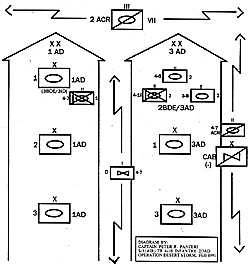 The 3rd Armored "Spearhead" Division crossed into Iraq on 24 February 1991 at the beginning of Operation Desert Storm's "100 Hour" ground war. Operation Desert Spear was progressing ahead of schedule.
The 3rd Armored "Spearhead" Division crossed into Iraq on 24 February 1991 at the beginning of Operation Desert Storm's "100 Hour" ground war. Operation Desert Spear was progressing ahead of schedule.
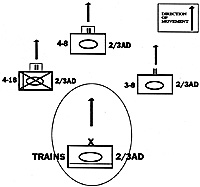 The Spearhead Division advanced northeast with its three brigades in column. The "Iron Brigade" led in wedge formation: Task Force 4-8 Cavalry leading (42 M-1's and 20 BFV's), 3-8th Cavalry on the right (56 M-1s, and 6 BFV's), and TF 4-18 on the left.
The Spearhead Division advanced northeast with its three brigades in column. The "Iron Brigade" led in wedge formation: Task Force 4-8 Cavalry leading (42 M-1's and 20 BFV's), 3-8th Cavalry on the right (56 M-1s, and 6 BFV's), and TF 4-18 on the left.
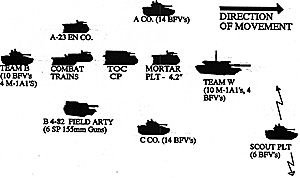 The 4-18 Scout Platoon was used to screen the Task Force front and maintain contact with the Task Force 4-8 CAV to the right front. The tanks, leading, moved in company and platoon wedge formations. All other combat elements moved in various formations. The Task Force Combat Trains (over 65 vehicles) moved in four long, single file columns.
The 4-18 Scout Platoon was used to screen the Task Force front and maintain contact with the Task Force 4-8 CAV to the right front. The tanks, leading, moved in company and platoon wedge formations. All other combat elements moved in various formations. The Task Force Combat Trains (over 65 vehicles) moved in four long, single file columns.
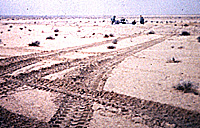 It was called "the mad minute." The eruption of firepower was enormous. Every Bradley in A Company opened fire simultaneously. The Iraqi infantry fired RPG rockets, but none struck home. The surprised BMP crews fired Sagger missiles and 73mm rounds at the Bradleys, but all missed.
It was called "the mad minute." The eruption of firepower was enormous. Every Bradley in A Company opened fire simultaneously. The Iraqi infantry fired RPG rockets, but none struck home. The surprised BMP crews fired Sagger missiles and 73mm rounds at the Bradleys, but all missed.
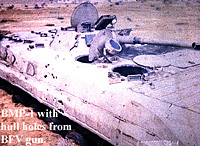 The Brigade Commander was also concerned about the vulnerability of his northern flank. He ordered a company of M1A1 tanks (Company D, 3-8 CAV) to move from the far right flank and reinforce Task Force 4-18. The 4-18 scout platoon leader went and guided them to 4-18's area.
The Brigade Commander was also concerned about the vulnerability of his northern flank. He ordered a company of M1A1 tanks (Company D, 3-8 CAV) to move from the far right flank and reinforce Task Force 4-18. The 4-18 scout platoon leader went and guided them to 4-18's area.
 The BMPs were hidden behind a low rise, and that is where Task Force 4-18 sat at daybreak, right in the middle of the Iraqi defense.
The BMPs were hidden behind a low rise, and that is where Task Force 4-18 sat at daybreak, right in the middle of the Iraqi defense.